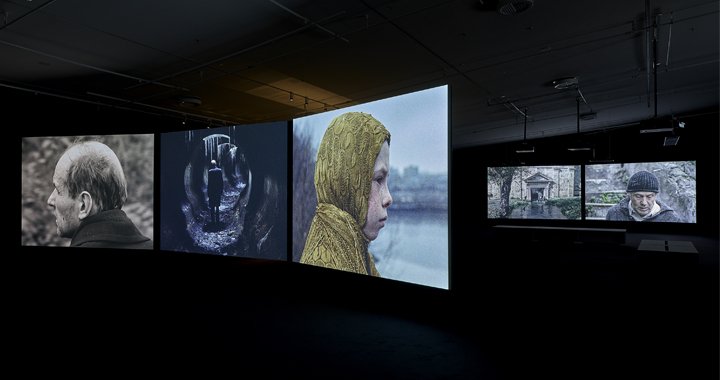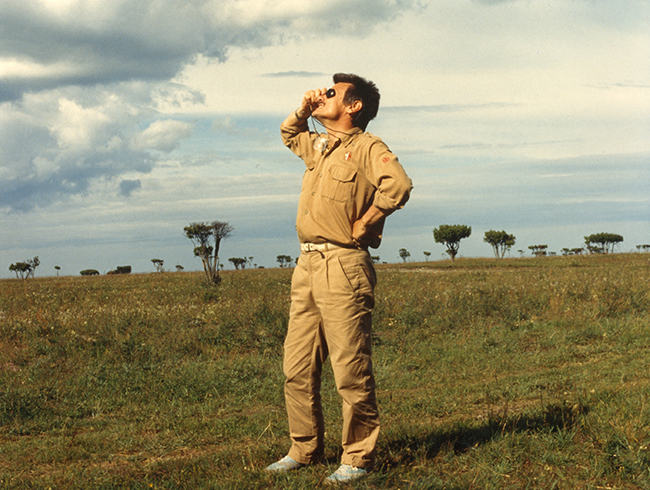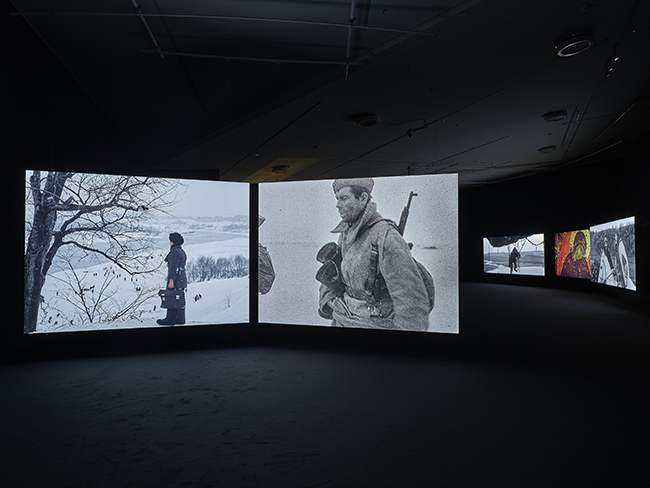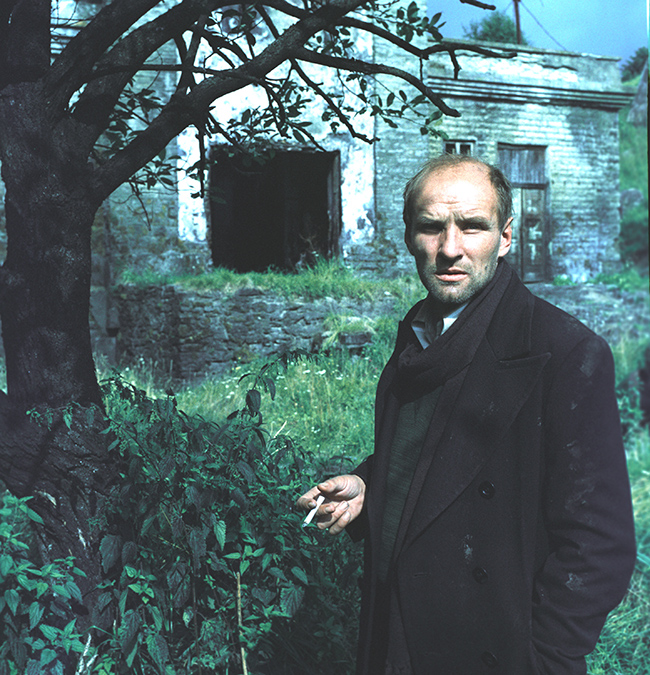
Andrei Tarkovsky. The Exhibition
Review of Andrei Tarkovsky retrospective at the Eye Filmmuseum in Amsterdam
23/10/2019
It’s a film about you, your father, your grandfather, about someone who will live after you and who is still “you”. About a Man who lives on the earth, is a part of the earth and the earth is a part of him, about the fact that a man is answerable for his life both to the past and to the future.[1]
An acclaimed Soviet filmmaker, Andrei Tarkovsky doesn’t need a special introduction today. Anyone with the slightest bit of interest in cinema can name at least one of his masterpieces, such as “Solaris”, “Stalker” or “Mirror”. His work has been analyzed from most every possible angle, even by Tarkovsky himself (in “Sculpting Time”, his book of writings ), and critics have been praising him for years. “None of us can understand how Tarkovsky, by means of the cinema, has succeeded in producing a work of such psychological depth.”[2] However, over 30 years after the completion of his last showpiece, he still remained the most mysterious and misunderstood of the Russian directors. Coming to our aid with this puzzle is the exhibition of Tarkovsky’s oeuvre organized at the Eye Filmmuseum in Amsterdam (till December 6th), which pays tribute to the existential aspect of the filmmaker’s work.

Andrei Tarkovsky on the set while filming the Sacrifice, 1986
For the past few years, the museum has mostly focused on contemporary video art or film-related works by established visual artists like William Kentridge, Hito Steyerl, Jesper Just, and Omer Fast, to name just a few, which makes it even more pleasing to see the institution present a celebrated film director.
The straightforward title, “Andrei Tarkovsky. The Exhibition”, actually says it all. The show doesn’t try to be something that it is not – it is simply an homage to the great director and his movies. If one were to just look at the way the exhibition has been laid out (mostly focusing on his most acclaimed films, from “Ivan’s Childhood” to “Sacrifice”), one might venture the opinion that it presents “Tarkovsky in a nutshell”. However, although the narrative of the show follows a chronological timeline, it is not just a retrospective as understood in the traditional sense.

Andrei Tarkovsky exhibition at the Eye Filmmuseum. © Studio Hans Wilschut

Andrei Tarkovsky, Ivans childhood, 1962
The exhibition does not try to present Tarkovsky as an artist, nor does it put his work into a fine-art context nor compare his oeuvre with contemporary works. Nevertheless, it is hard not to think of the influence that his imagery has left on contemporary cinema and visual art[3]. In addition to presenting a full retrospective of Tarkovsky’s films as well as the films that inspired them, the film programme accompanying the exhibition also presents productions by other filmmakers that were inspired by Tarkovsky, if not more or less directly influenced by the Tarkovsky universe (e.g. films by Alex Garland, Chris Marker, Carl Reygados, Lars von Trier, and others).
Tarkovsky’s relation to time, in terms of being “imprinted” within the apparatus, seems to be closer to the medium of photography than the moving image of cinema. Analyzing it “helps us to understand the peculiar poignancy of Tarkovsky’s films, which rests neither in their narrative nor in their ideological explication, but in the irreducible materiality of their projection.” [4] This materiality is enhanced by the masterful play of long studies of everyday life disturbed by the sudden appearance of the supernatural, the result of which is the meeting of both realities – the spiritual and the physical – in the same plane, i.e. the image. This is most likely why his films work so well when presented in the context of an art museum.

Andrei Tarkovsky, Vicino a Bagno Vignoni, 1979-1982, Italy, Polaroid
For the purposes of “The Exhibition”, each of Tarkovsky’s masterpieces is presented on a few separate screens (arranged in forms of diptychs and triptychs, they create a “cinematic iconostasis”), taken apart and dissected, but in a very cautious way – by showing carefully curated excerpts. Consequently, it all creates a rhythmic visual essay in which one can get lost, and they could almost be mistaken for fragments sourced from just one film. The size of the screens is slightly smaller than that of an average cinema, which allows one to immerse oneself into Tarkovsky’s spiritual world and analyze the psychology of each scene. In addition, the fact that that the screens have been placed at eye level (instead of higher up, as in a regular movie theater) eliminates the separation of viewer and film. In fact, each individual scene appears as strong and compelling as a whole film in its entirety.
Having the screens arranged in a space so that the viewer can walk between them not only allows the viewer to experience Tarkovsky’s metaphysics more profoundly, but also creates a strong architectural aspect for the whole room containing the exhibition. Indeed, architecture and space (inextricably linked with the previously mentioned idea of time) play an immense role in Tarkovsky’s cinema. “If an author is moved by the landscape chosen, if it brings back memories to him and suggests associations, even subjective ones, then this will in turn affect the audience with particular excitement.”[5] This tension between space and time, manifested in the subversive art of sublime long shots and the arrangement of particular scenes, allow the viewer to be drawn into the reality of the film in the same way they would enter a building.

Andrei Tarkovsky, Stalker, 1979
The whole concept of mise-en-scène (the arrangement of everything that appears in the frame – actors, lighting, décor, props, costumes) in Tarkovsky’s films, rather than illustrating ideas, follows life – the personalities of the characters and their psychological states. “As soon as a mise-en-scène turns into a sign, a cliche, a concept (however original it may be), then the whole thing – characters, situations, psychology – become schematic and false,” explains the filmmaker himself[6]. Tarkovsky’s movies are powerful enough; they stand up for themselves, and therefore no special props, stage design or other materials from the set are needed to be displayed. Much in the same way as it’s impossible to exhibit someone’s personality.

Andrei Tarkovsky, Bagno Vignoni, 1979-1982, Italy, Polaroid
Instead, complementary to the video projections, the exhibition displays Tarkovsky’s letters, Polaroids, and photographs (which have never been shown before in the Netherlands), as well as his lesser-known theatrical activities (e.g. “Hamlet”, 1977). Together, they illustrate how consistent Tarkovsky was in his visual language and create a rather harmonious supplement to the films as another body of exhibits. Much like in his cinematic works, the world in Tarkovsky’s Polaroids “is already an image in a kind of historical succession that relates to something that he has seen before, whose construction he already knows about”[7], observed Boris Groys.
Cinema is a relatively young art, but Tarkovsky managed to make if feel monumental. Watching his films is like looking at old masters’ paintings or bronze sculptures in the Rijksmuseum next door. “Touched by a masterpiece, a person begins to hear in himself that same call of truth which prompted the artist to his creative act.”[8]

Andrei Tarkovsky, Nostalghia, 1983
For those who were familiar with Tarkovsky’s body of work before coming to the Eye Filmmuseum, “The Exhibition” is similar to the experience of looking at an old family album and confusing your memories with photographs that you’ve seen before. But it is more than just a personal experience. Tarkovsky shows us the essence of our existence and takes us through a spiritual journey in search of our identity, both on an individual and social level. And this is why his movies seem to be more relevant today than ever before. “We have reached the point where, as Stalker says, the present has essentially merged with the future, in the sense that it contains all the preconditions for immanent disaster; we recognize this and yet we can do nothing to stop it happening.”[9]

Andrei Tarkovsky on the set while filming the Mirror
[1] Andrei Tarkovsky, Sculpting in Time, University of Texas Press, 1989, p.9
[2] Op. cit.
[3] In his essay “Andrei Tarkovsky and Contemporary Art: Medium and Mediation”, Robert Bird mentions works by artists such as Susan Hiller, Gerhard Richter, Jeremy Millar, Tacita Dean, Mark Wallinger, and Douglas Gordon. Robert Bird, ‘Andrei Tarkovsky and Contemporary Art: Medium and Mediation’, in Tate Papers, no.10, Autumn 2008, https://www.tate.org.uk/research/publications/tate-papers/10/andrei-tarkovsky-and-contemporary-art-medium-and-mediation, accessed 16 October 2019.
[4] Op cit
[5] Andrei Tarkovsky, Sculpting in Time, University of Texas Press, 1989, p.28
[6] Andrei Tarkovsky, Sculpting in Time, University of Texas Press, 1989, p.25
[7] Boris Groys, ‘Tarkovsky’s Documentary Romanticism’, in Andrey Tarkovsky, Bright, Bright Day, p.125.
[8] Andrei Tarkovsky, Sculpting in Time, University of Texas Press, 1989, p.43
[9] Andrei Tarkovsky, Sculpting in Time, University of Texas Press, 1989, p.235